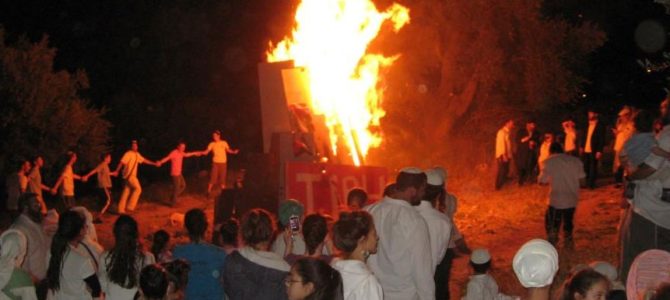Lag ba’Omer is a minor Jewish holiday celebrated with bonfires and an occasion for weddings and cutting children’s hair. It happens approximately one month after Passover, and the name means the 33rd day of the of the Omer count, on the 18th day of the Jewish month of Iyar, which is about the midpoint in time between Passover and Shavuot.
Lag ba’Omer, according to tradition, was the day on which the plague that killed 24,000 of Rabbi Akiva’s disciples stopped (Yebamoth, 62:72). For this reason it is customary to cease mourning customs of the Omer period, which include prohibition of marriages, cutting hair, and public expressions of joy such as singing and dancing. Some traditions hold that the period of mourning ends at Lag ba’Omer and others end it three days before the holiday of Shavuot.
Traditionally, Lag ba’Omer is the date of the passing of Rabbi Shimon bar Yochai who lived during the 2nd century CE. He was one of the prominent disciples of Rabbi Akiva and was his pupil at the time of Rabbi Akiva’s arrest by the Romans (Pesahim, 112:71). Following the failed attempt of the Bar Kochva Revolt against Caesar Hadrian (Roman emperor between 117-138 CE) and the death of Rabbi Akiva’s disciples, Rabbi Shimon bar Yochai became one of the five disciples to “erect the Torah” (Yebamoth, 62:72). The Roman Caesar’s decrees and the death of Rabbi Akiva’s martyred colleagues brought Shimon bar Yochai to hate Rome and its culture and to oppose its rule (Shabbat, 33, 72). He refused to accept the results of the revolt and was sentenced to death for his verbal opposition towards Roman rule. His son Elazar accompanied him in his escape to a cave in the Galilee, where they remained isolated for 13 years. At this period of time Shimon bar Yochai consolidated his views on the great importance of Torah studies. After coming out of hiding, Rabbi Shimon bar Yochai was not admitted to the Sanhedrin in Usha, possibly for fear from the Romans, but at a later time, after the expiration of his sentence, he took part in an expedition of sages from Eretz Yisrael to Rome, working successfully to annul the decree against circumcision (Me’ilah, 17:71-72).
Shimon bar Yochai’s admired personality, “knowledge of miracles” (Me’ilah, 17:72), solitude and years of seclusion, made him–since the era of Gaonim–a mystical figure, with messianic and apocalyptic undertones. For example, when the Zohar was published in the 13th century, kabbalists ascribed it to Shimon bar Yochai.


